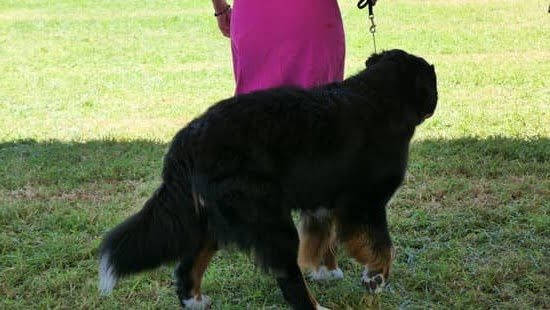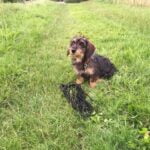Introduction
Dogs bite for many reasons, whether it’s out of fear, anxiety, stress, defensive behavior or aggression. It’s important to understand why your dog might be biting in order to properly address the problem. By taking a few simple steps you can help create a more positive behavior in your canine companion and help train them not to bite people.
One major reason why dogs might bite is from feeling stressed or anxious. Dogs generally don’t react well when put under too much pressure. This could be because of uncomfortable surroundings, another animal nearby or its own uncertainty about what is about to happen. It’s important to recognize these signs of stress and take steps to alleviate the situation before it escalates. That may involve introducing them slowly to unknown situations; providing plenty of physical and mental stimulation; accustoming them with regular change-ups & routines; or rewarding their good behavior with treats & praise.
It’s also essential that you remain consistent when training a dog that bites a lot—this helps promote trust and understanding between pet owner and pet. A structured routine also allows your pet to anticipate when they will be receiving food, exercise and attention so they can better manage their emotions and feel secure in their environment. When disciplining your pup after an incident involving biting make sure you stay calm—yelling or screaming at them will only exacerbate the problem and could cause your pet more anxiety which leads to more unwanted behaviors like more aggressive biting. Lastly, reward them whenever they exhibit positive behaviors in place of negative ones like when they stop trying to bite people or other animals and favor other activities such as playing with toys or fetching balls instead. Rewarding lessens the chances of any future undesirable occurrences from repeating themselves since pets thrive off habits that are occasionally rewarded with treats.
Identifying the Root of the Problem
When attempting to train a dog that bites a lot, it is important to first identify the root of the problem and assess the dog’s needs. Before proceeding with any kind of training, it is essential to establish a behavioral baseline so you can determine how your pooch behaves in various situations. You will need to observe them from a safe distance and take note of their behaviors in different contexts. Do they get more aggressive during meal times? Do they bark excessively when people approach them? Different triggers may cause severe anxiety or aggression, so learning what these triggers are for your pet will help you set up an effective training plan.
In addition to observing the dog’s behavior and noting potential trigger points, getting professional help from an experienced animal trainer can be invaluable. A qualified trainer can provide valuable expertise and guidance in understanding your pup better as well as helping you create an effective training plan based on both knowledge and experience. They can also discuss potential solutions such as using special treats or toys that help calm the mood or providing intervention if needed. This approach will ensure that all of your pup’s needs are being met in order to foster positive change in their overall behavior.
Preparing to Train
Training a dog that bites a lot can be challenging and risky. To maximize safety, it is important to create an environment that is consistent and safe. It is best to have one person dedicate themselves to being the main trainer/handler when working with the dog. This will help create trust between the handler and the canine, as dogs often respond better when they are familiar with the person in charge. Additionally, make sure you have consulted your veterinarian and possess all necessary supplies needed (e.g., a leash, treats, etc.) Finally, set up clear expectations for both you and your dog by writing out rules like “no biting” and providing positive reinforcement when these rules are followed. After these steps have been taken, the next step to training a dog that bites a lot should be slowly introducing more challenging tasks like walking outside or playing with other dogs after getting permission from your vet. Additionally, it might be beneficial to enroll your pup in classes so they can develop social skills under professional guidance. Lastly, make sure you stay consistent with your commands and reward good behavior so that your pup knows what is expected of them. Following these key steps will ensure success in training any dog who may suffer from bad biting habits!
Practicing Discouragement Techniques
When trying to train a dog that bites a lot, it is important to practice discouragement techniques in order to teach the dog what not to do. This can best be accomplished by informing the dog of its wrong behavior as soon as it happens, followed by showing and possibly rewarding a more desirable behavior. It is also important to avoid frustration when training a dog that bites, and instead stick with consistent positive reinforcement. To accomplish this, reward the dog for doing something correctly rather than punishing it for biting or other undesirable behaviors. As part of your training program, use commands such as “sit” or “down” and then reward the dog when they follow these commands properly. You may also want to introduce basic obedience exercises such as walking on a leash or retrieving objects and then have praise and treats handy as rewards whenever they obey your commands. When discarding toys or bones, try not to elicit an overly excited response from your pet, instead keeping them calm and avoiding any potential trigger points that could lead to biting. Lastly, limit playtime interactions with children if possible so that unwanted situations leading up to biting can be avoided all together.
Repetition and Training
Training a dog that bites a lot is no easy task. It requires patience, consistency and lots of commitment. However, using repetition and positive reinforcement strategies can help you to channel your pup’s biting behavior into something more appropriate.
The first step towards training a biting dog is understanding why the behaviour occurs in the first place. Dogs typically bite out of fear, pain or anger. By understanding the root cause of the behaviour, owners are better able to provide them with appropriate outlets for their aggression.
Once you know the reason your pup is exhibiting aggressive behavior, it’s time to start redirecting his focus from biting onto something else that is more beneficial or productive. Positive reinforcements such as treats or verbal praise can be used to reward desirable behaviors like sitting and staying down in order to reinforce desired behavior instead of resorting to biting. Additionally, training your pup with commands like “no bite” will help him learn acceptable ways to express himself rather than resorting to biting when feeling frustrated or anxious.
Finally, practice makes perfect! Repetition is key when it comes to teaching new behaviors and reinforcing the commands you’ve taught your pup. Rewarding your pup for following commands on a consistent basis helps him understand boundaries while also providing him with reminders that you are there for support.
Praise and Rewards
One of the most important steps to training a dog that bites a lot is to use praise and rewards. Praise your dog and give them treats or rewards when they exhibit desirable behaviors, such as sitting on command or coming when you call. This will not only encourage your dog to repeat the behavior, it will create positive feelings associated with those behaviors.
When addressing biting, avoid punishment. Punishment can increase anxiety and fear in some dogs, which can make problems worse. Instead, try redirecting the bad behavior towards something positive (such as giving them a chew toy). Reinforce good behavior by praising and rewarding your dog instead of scolding or punishing them when they become overly aggressive or bite.
Make sure to move at a slow pace and keep sessions short — about 5-10 minutes is usually about right for puppies — so your pup doesn’t become overwhelmed or frustrated with the learning process. Create playtime that focuses on stimulating activities such as fetching balls or tugging on toys. This can help improve impulse control and reduce instances of biting during playtime.
Finally, remember that patience is key when training any dog – especially one that bites a lot. Like any other behavioral issue, it may take persistent reinforcement and time to see results in your pet’s attitude towards biting and aggression issues.
Consulting a Professional
When it comes to training a dog that bites a lot, consulting with a professional is the recommended first step. Working with an experienced and qualified behaviorist, canine trainer, or veterinarian can help diagnose potential causes of excessive biting and veterinary issues that could be the underlying cause. A qualified professional can also accurately assess the temperament and physical wellbeing of your dog and may employ a variety of techniques to reduce aggressive behaviors. Techniques such as desensitization and counterconditioning are used to gradually introduce your dog to different stimuli without triggering aggression. Positive reinforcement-based methods are frequently used for teaching impulse control and alternative behaviors to replace unacceptable ones. In certain cases, medications may be prescribed which can help modify problem behaviors or address underlying medical or environmental causes. The use of e-collar training may also be employed if appropriate for the situation. It is important to seek out proven professionals when it comes to potentially dangerous behavior issues like excessive biting in order to ensure your pet has the best chance at learning acceptable behaviors that keep everyone safe.
Long-Term Strategies
It is important to remember that training any dog, especially one that has a history of biting, is an ongoing process. Establishing a consistent environment and reinforcing commands regularly helps maintain the behavior post-training. Having a routine that establishes when and where the dog should be receiving commands and rewards is essential to maintaining structure and discouraging biting. For example, take your dog for daily walks in familiar locations with distractions present; provide treats for completing the task correctly. Additionally, give verbal praise or patting on the head following positive reinforcement instead of giving them toys or treats as these could serve as triggers for certain unwanted behaviors such as biting. Finally, make sure you get help from experienced professionals if needed. This will ensure that you are giving your pup the best guidance and help possible throughout their training journey.
Conclusion
Training a dog that bites a lot can be very difficult, however, it is essential for the safety of the animals and people around them. The first step in properly training a dog that has aggressive tendencies is to no longer allow it to bite or lunge. This can be done through redirection, distraction, and positive reinforcement. Once you have put an end to their bad habits, you should then focus on teaching them commands such as sit, stay, come and leave it. These commands should be used consistently with treats as rewards so they learn to associate certain behaviors with pleasant rewards. Avoid using physical punishments during any sort of dog training session as this might lead to further aggression being expressed by your pooch.
By using proper training techniques in combination with patience and consistency you will be able to successfully train a dog that bites a lot. It is important develop trust between yourself and your pet by providing plenty of exercises, spending time with them, playing with them and providing treats when they listen to commands. And most importantly it is essential to make sure everyone around the pup understands how serious biting can be and how to properly react when faced with aggression from your pet. Following these enforcing rules will ensure your pup develops into an obedient companion that doesn’t pose a threat any longer.

Welcome to the blog! I am a professional dog trainer and have been working with dogs for many years. In this blog, I will be discussing various topics related to dog training, including tips, tricks, and advice. I hope you find this information helpful and informative. Thanks for reading!





